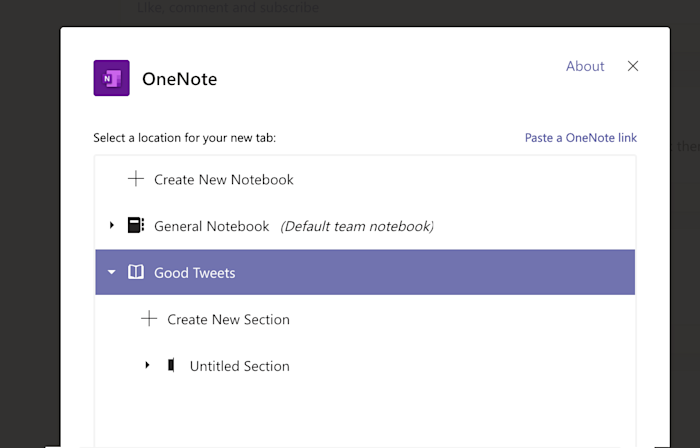Work with Outlook and OneNote. Integrate OneNote with Outlook to organize tasks, meeting notes. The Wiki is fast and simple but only works inside Teams. OneNote offers more features and can be used outside Teams. My advice: if the Wiki works for you, that's great. If you want more out of your note-taking, and the ability to reference notes outside of Teams, use OneNote.
When a staff creates a Staff Team for all the staff, on Teams, a Notebook for only the staff is also created.
Jump to:
People also search for:
How to use the Staff Notebook on Teams:
- Click on the Staff Notebook on the top bar.
- The staff notebook contains three main sections.
- It contains the Collaboration space, Content library, and Personal space for each staff.
- Each section has unique permissions depending on the owner’s rights of the staff in the team.
- The collaboration space is for everyone to collaborate in the team.
- Content added to the Content Library is read-only for the other staff members.
- That means you can create content for Content Library and other staff can only view it.
- Each notebook has some pre-populated pages.
- These pages can guide you to work with your staff.
- This is an example for pre-populated pages.
- Each staff member will get a private section in the staff notebook.
- The team owner can view all the private sections of all the staff.
- The staff member cannot see each other’s personal section.
- All member staff can document Parent Communication and Professional Development goals.
- Team owners have access to Class Observations, Lesson Plan Feedback and Evaluation.
- Therefore the team owners can provide valuable information on them.

What is staff notebook on teams:
When a new team is created by a staff a Staff Notebook is also created on the OneNote. This staff notebook is very useful for all the staff in a class or school. It has three important sections which are given above. These sections can be very useful for organizing and collaborating with other staff members.
Microsoft teams have many options for student collaborations as well as staff collaboration. One of the most important features for staff collaboration is the OneNote notebook. Detailed instructions on staff collaboration on OneNote is given above.
Verdict:
There is an increase in the usage of online classrooms recently. Microsoft Teams is the main solution for online collaboration for schools and companies alike.
Here we see how we can use staff notebook ok for collaborating with other staff members. It has many important features that should be carefully noted.

If you need to know more about the Staff Notebook please let us know in the comments below.
For more awesome posts stay tuned to TecKangaroo.
What's your reaction?
© Provided by Windows CentralYou can use OneNote within Microsoft Teams, and this guide, we'll outline the steps to install, manage, and remove the app on Windows 10.
If Microsoft Teams and OneNote are already part of your daily work routine, instead of switching back and forth between apps and using additional steps to share notebooks with colleagues, you can install the OneNote app on Teams to simplify the experience.
Once the app is added to Microsoft Teams, you can add new or existing notebooks to share content (such as lits, notes, drawings, etc.) and collaborate with colleagues without breaking your workflow.
In this Windows 10 guide, we'll walk you through the steps to integrate OneNote into Microsoft Teams.

- How to install OneNote on Microsoft Teams
- How to rename OneNote notebook on Microsoft Teams
- How to remove OneNote notebook on Microsoft Teams
- How to delete OneNote notebook on Microsoft Teams
- How to uninstall OneNote on Microsoft Teams
How to install OneNote on Microsoft Teams
To add OneNote to a team or chat on Microsoft Teams, use these steps:


- Open Microsoft Teams.
- Click on Apps.
Click on OneNote. Free studio for mac.
© Provided by Windows CentralQuick tip: If you don't see the app, perform a query for 'OneNote' in the search box.
Click the down-arrow button and select Add to a team or Add to a chat option.
© Provided by Windows Central- Click the search box and specify the team to add OneNote.
Click the Set up a tab button.
© Provided by Windows CentralClick the Create New Notebook option.
© Provided by Windows CentralConfirm the name for the new notebook for the team.
Quick tip: You'll also notice an option to open an existing notebook using a link, but it's only supported for notebooks hosted in SharePoint or OneDrive for Business.
Select the newly created notebook.
© Provided by Windows Central- (Optional) Create new sections as needed.
- (Optional) Clear the Post to the channel about this tab option.
- Click the Save button.
Once you complete the steps, the notebook will be created in the Microsoft Teams storage, and anyone in the channel will be able to see and modify its contents.
Microsoft Teams
© Provided by Windows CentralMicrosoft Teams allows you to communicate and collaborate with colleagues, upload files, and chat through video. It integrates with Microsoft 365 and many other cloud services.
How to rename OneNote notebook on Microsoft Teams
To change the name of the OneNote notebook tab, use these steps:
- Open Microsoft Teams.
- Click on Teams or Chats depending on where the notebook is located.
Click the down-arrow button and select the Rename option.
© Provided by Windows CentralConfirm the new name.
© Provided by Windows Central- Click the Save button.
After you complete the steps, the new name will be reflected in the notebook tab.
Onenote For Team Collaboration
Rename notebook
To rename the actual OneNote file, use these steps:
- Open Microsoft Teams.
- Click on Teams or Chats depending on where the notebook is located.
- Click the Files tab.
Select the OneNote notebook.
© Provided by Windows Central- Click the Rename button.
- Confirm the new name.
- Click the Save button.
Once you complete the steps, the OneNote file and tab will reflect the new name.
How to remove OneNote notebook on Microsoft Teams
If you no longer need the OneNote notebook, you can always remove it from Microsoft Teams.
To remove a notebook on Teams, use these steps:
Download Onenote For Teams
- Open Microsoft Teams.
- Click on Teams or Chats depending on where the notebook is located.
Click the down-arrow button and select the Remove option.
© Provided by Windows Central- Click the Remove button again.
Once you complete the steps, the OneNote notebook will no longer be available on Microsoft Teams.
How to delete OneNote notebook on Microsoft Teams
The action to remove doesn't delete the notebook and its content. It only removes it from the Teams experience. If you want to delete the notebook, you need to do it from the 'Files' tab.
To delete a notebook on Teams, use these steps:
- Open Microsoft Teams.
- Click on Teams or Chats depending on where the notebook is located.
- Click the Files tab.
Select the OneNote notebook.
© Provided by Windows Central- Click the Delete button.
Mac os styles for xp. After you complete the steps, the notebook will be deleted from Microsoft Teams.
If the notebook you're trying to delete isn't in the 'Files' tab, make sure you in the correct chat or team. You can also check the Files section from the left pane and see if the file appears under the OneDrive section.
How to uninstall OneNote on Microsoft Teams
Onenote For Teams Desktop
To uninstall OneNote on Teams, use these steps: General cms for mac.
- Open Microsoft Teams.
- Click on Teams.
Right-click a team with the app and select the Manage team option.
© Provided by Windows Central- Click the Apps tab.
Click the Uninstall button for OneNote.
© Provided by Windows Central- Click the Uninstall button again to confirm.
After you complete the steps, the app will be uninstalled from the team. Same as removing a notebook, uninstalling the app doesn't delete the notebooks or their contents. Alternatively, you can also right-click the OneNote icon from the left pane, and click the Uninstall button to remove it.
More Windows 10 resources
For more helpful articles, coverage, and answers to common questions about Windows 10, visit the following resources:
